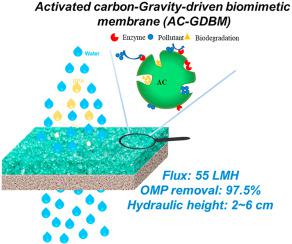Journal of Cleaner Production ( IF 9.7 ) Pub Date : 2021-07-05 , DOI: 10.1016/j.jclepro.2021.128224 Wensong Chen 1 , Jiaming Luo 1 , Xing Du 2 , Luhui Ding 3 , Wenxiang Zhang 1

|
Gravity-driven biomimetic membrane (GDBM) has been developed as a promising membrane separation technology regarding ecological water treatment. Given its catalytic function on micro-pollutant removal and fouling control, detailed mechanism for fabrication material influence, organic micro-pollutants (OMPs) degradation, and operation strategy optimization have not been clear so far. In this work, the GDBM performance with various activated carbon (AC) materials (wood, coal, column and powder AC), and hydrostatic heights were investigated and verified. The activated carbon-gravity driven biomimetic membrane (AC-GDBM) fabrication tests demonstrated that AC-GDBM with powdered wooden AC had better filtration performance (up to 55 LMH flux and 97.5% removal rate) than AC-GDBM with other ACs. Furthermore, the effects of operation strategies (AC dosage, lacasse dosage, carbamazepine (CBZ) concentration, hydraulic height and rotating speed) on the filtration performance of AC-GDBM were conducted. At 25 g m−2 AC dosage, 30 g m−2 lacasse dosage, 10 mg L−1 CBZ concentration, and 5 cm hydraulic height, the optimized flux and removal rate were obtained. Further investigation revealed the surface morphology and property of AC-GDBM, displaying that powdered wooden AC and laccase formed the even biomimetic layer on base membrane. Additionally, for treating various OMPs (CBZ, tetracycline hydrochloride (TET), quinolones (norfloxacin (NFX)), and sulfonamides (sulfamethoxazole (SMZ))), with the optimized conditions, the removal rate and flux of AC-GBDM could maintain at high levels. This study demonstrates an example of a niche application, where GDBM is expected to offer a highly efficient and cost-effective ecological water treatment technology.
中文翻译:

用于有机微污染水处理的活性炭-重力驱动仿生膜(AC-GDBM)
重力驱动仿生膜(GDBM)已被开发为一种有前途的生态水处理膜分离技术。鉴于其对微污染物去除和污染控制的催化作用,制造材料影响、有机微污染物(OMPs)降解和操作策略优化的详细机制目前尚不清楚。在这项工作中,研究和验证了各种活性炭 (AC) 材料(木材、煤、柱和粉末 AC)和静水高度的 GDBM 性能。活性炭重力驱动仿生膜 (AC-GDBM) 制造测试表明,与使用其他活性炭的 AC-GDBM 相比,使用粉末状木质活性炭的 AC-GDBM 具有更好的过滤性能(高达 55 LMH 通量和 97.5% 的去除率)。此外,操作策略的影响(交流剂量、漆酶用量、卡马西平 (CBZ) 浓度、水力高度和转速)对 AC-GDBM 过滤性能的影响。在 25 克米-2 AC用量、30 g m -2漆酶用量、10 mg L -1 CBZ浓度和5 cm水力高度,获得了优化的通量和去除率。进一步的研究揭示了AC-GDBM的表面形态和性质,表明粉末状的木质AC和漆酶在基膜上形成了均匀的仿生层。此外,对于处理各种OMPs(CBZ、四环素盐酸盐(TET)、喹诺酮类(诺氟沙星(NFX))和磺胺类(磺胺甲恶唑(SMZ))),在优化条件下,AC-GBDM的去除率和通量可以保持在高水平。这项研究展示了一个利基应用的例子,其中 GDBM 有望提供一种高效且具有成本效益的生态水处理技术。











































 京公网安备 11010802027423号
京公网安备 11010802027423号